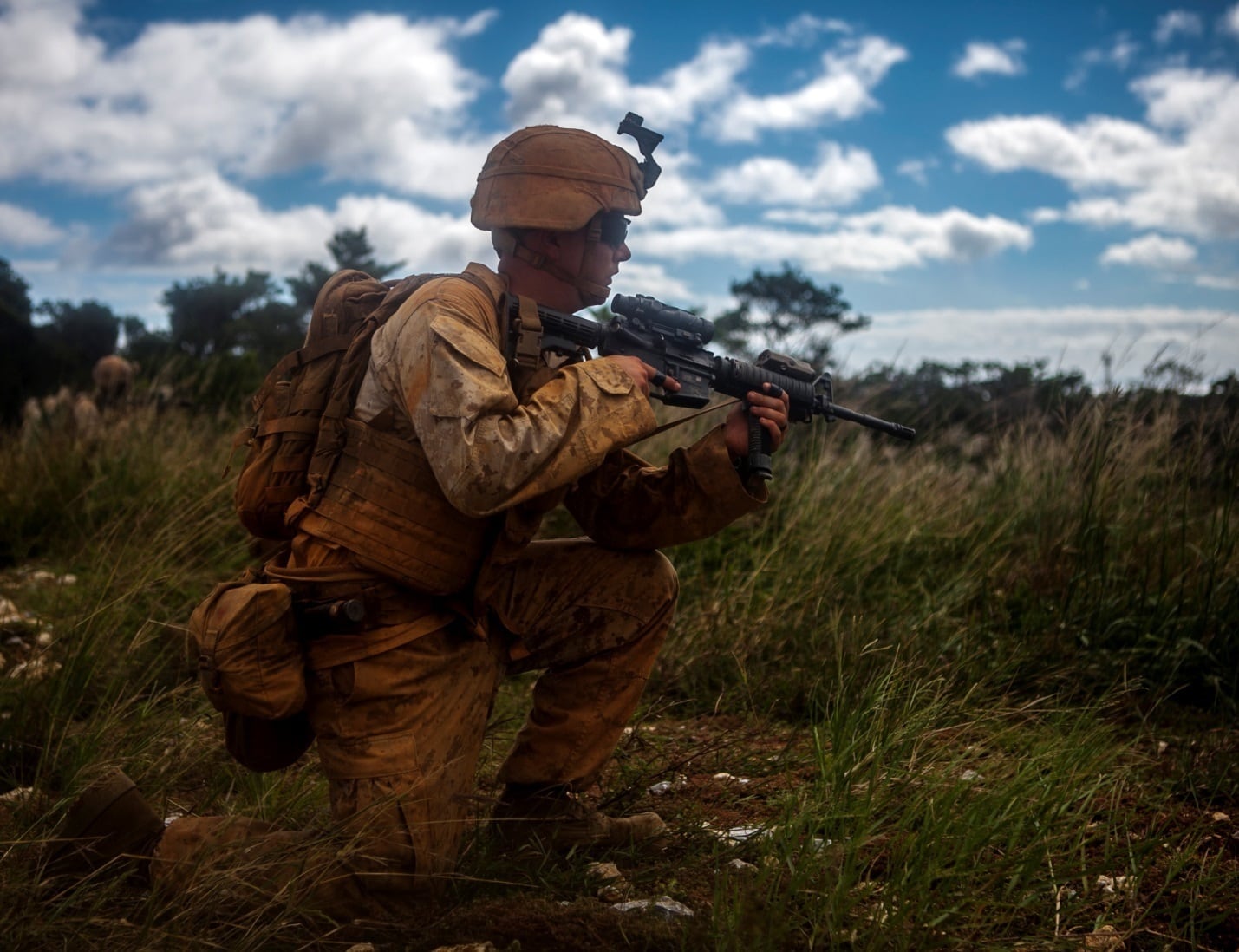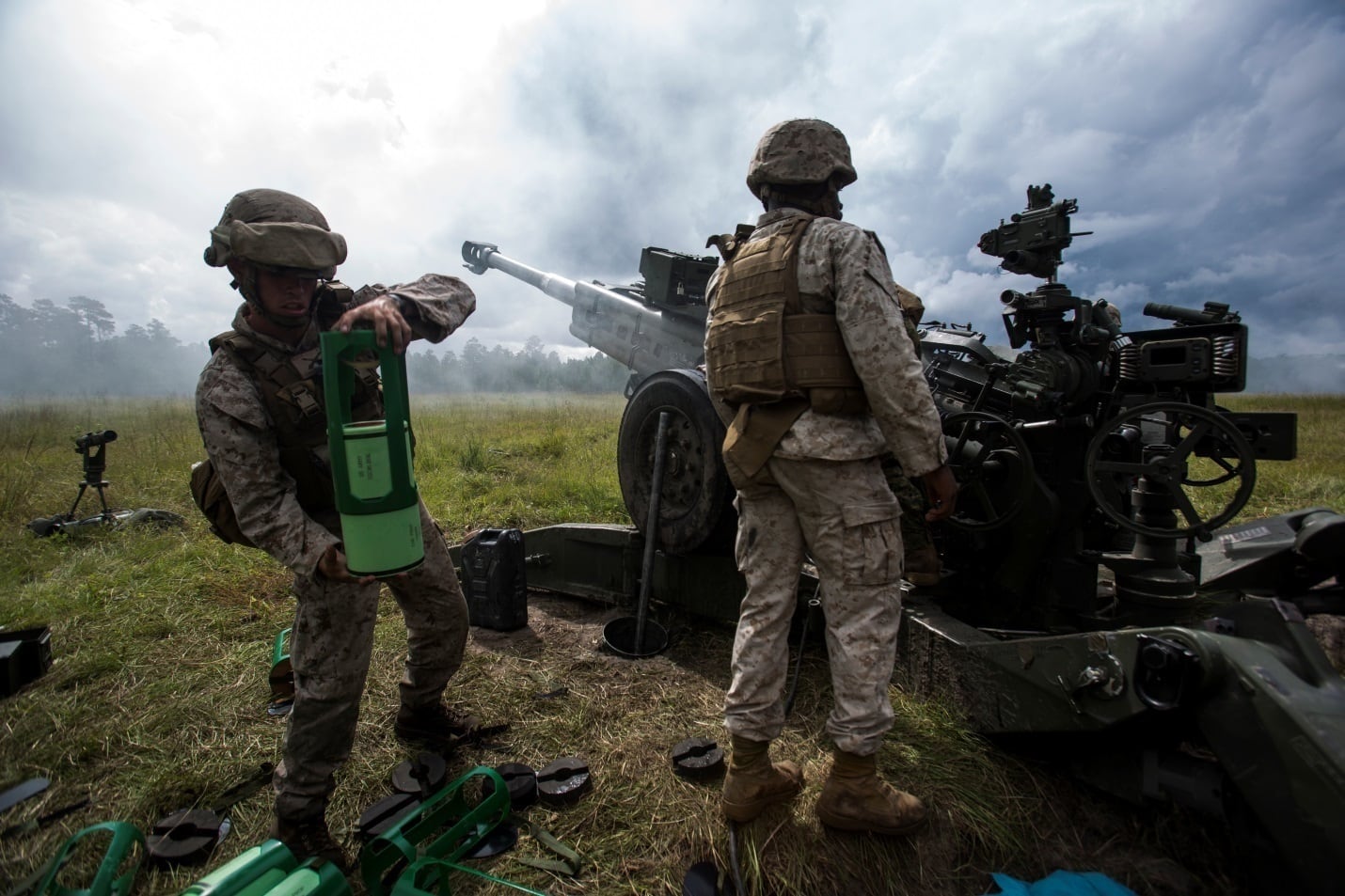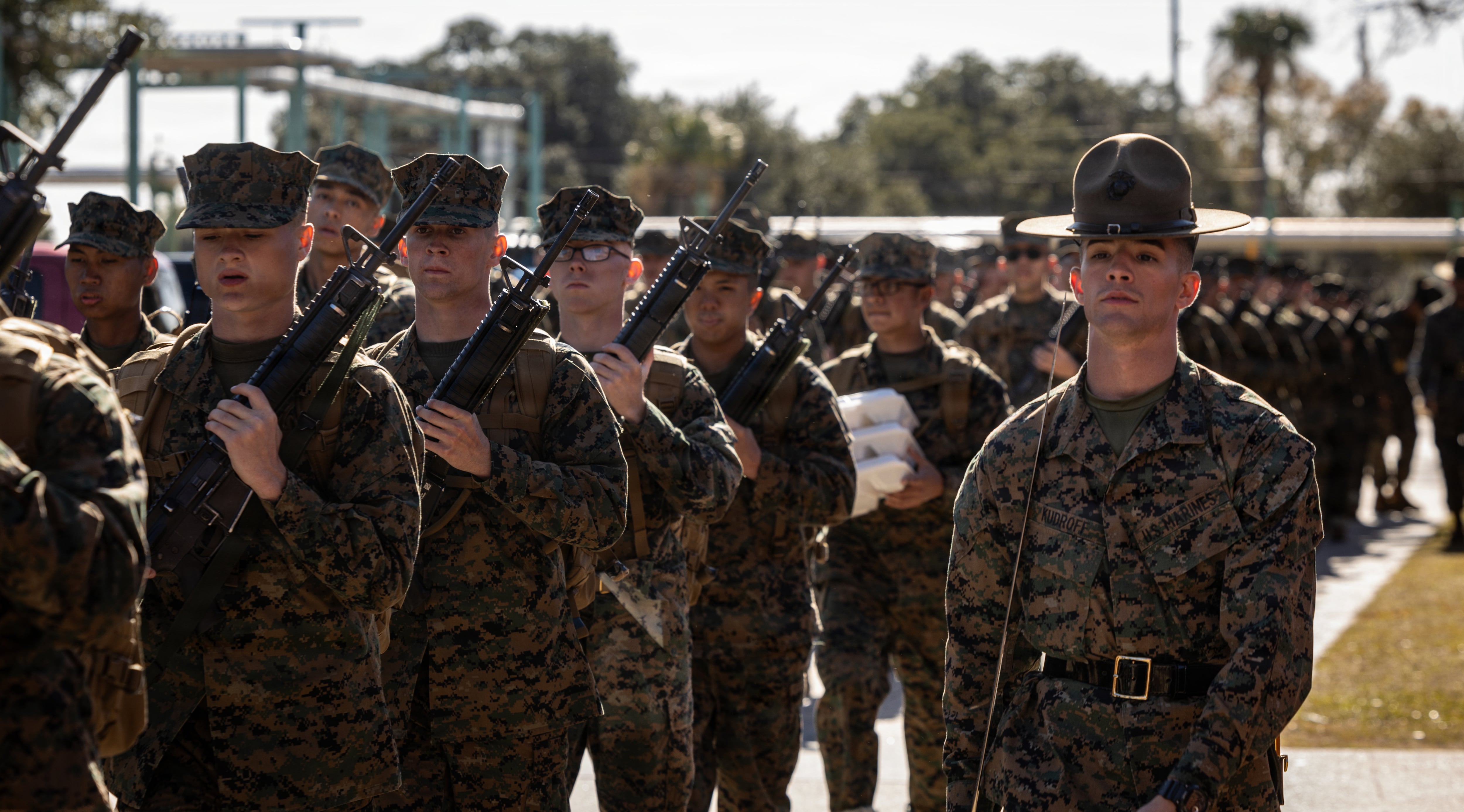The Marine Corps is on a mission to up its re-enlistment game.
With fewer first-term Marines signing on for another enlistment versus last year, manpower officials are calling called on commanders leadership Nov. 10 to ensure re-enlistment targets are met across 23 specific M military O occupational S specialties as part of the Corps' under its current First-Term Alignment Plan.
The FTAP aims to get seeks to make sure the right number of Marines are in the right MOSs across the force as the multi-year drawdown nears completion and the Corps has a harder time encouraging young enlisted troops to remain in uniformstay in. The slow-filling MOSs are in vital communities like the infantry, aircraft maintenance maintainers and artillerymen.
Now it's tasked commanders must to step up to the plate to fill at least 1,050 remaining boat spaces of its retention goal of nearly 6,000.[[Matt is there a target date on that? Just by the end of FY16?]] — Since there are about out of approximately 24,000 – first-term Marines whose current contract expires this fiscal year, according to Marine administrative message 567/15, that means Corps officials want about a quarter of them to sign on for another term.
"The comprehensiveness of the recent drawdown, coupled with continuing changes in the structure of the Marine Corps, demands that commanders apply renewed attention to ensure that the force retains sufficient Marines of the correct grades and MOSs," the MARADMIN states.
Since the FTAP goals for fiscal year 2016 kicked off in July, more than over 2,000 first-term Marines have re-upped. Sixty-on 61 MOSs have been filled and 83 more MOSs are on track to meet retention targets.
But A further 23 MOSs, however, are still behind the curve.
"These 23 MOSs have been determined to be slower-filling MOSs, meaning there is a potential for these boat spaces to be underexecuted," said Yvonne Carlock, a spokeswoman for Manpower and Reserve Affairs, told Marine Corps Times.
Grunts lead the pack as the Corps seeks to sign an additional 390 out of 4,992 infantrymen, machine gunners, mortarmen, infantry assaultmen and antitank missilemen, or about 8 percent of the eligible ir remaining EAS population.

Cpl. Benjamin Bacon provides security after exiting a CH-53E Super Stallion. Corps officials want more than 8 percent of first-term Marines in certain infantry military occupational specialties to re-enlist.
Photo Credit: Lance Cpl. Jessica Etheridge/Marine Corps
Motor transport is the next largest group: 176 out of 1,974, or 9 percent, of first-term automotive organizational technicians and motor vehicle operators are needed.
Artillery MOSs are also under the gun: 126 slots out of 623 Marines EASers, or roughly 20 24.4 percent, still need to be filled for field artillery cannoneers, radar operators, fire control men, sensor support men and fire support men. This last MOS is particularly short, with notably still requires 38 out of 90 men, or 42 percent of Marines in that job needing to re-enlist.
Data/communications maintenance fields require more the highest retention rate across those MOSs, with almost 28 of 26.25 percent, or 145 out of 526, needed to re-up. Those jobs include: technical controller Marines, multichannel equipment repairers, ground radio repairmen, and telephone systems/personal computer intermediate repairers.
Aircraft maintenance billets — including flight equipment technicians and unmanned aerial vehicle mechanics — have also been slow to fill. are also slow-filling MOSs, The Corps needs with 48 Marines of those first-term Marines, still needed out of 251, or 19 18.5 percent, to stay.
The five remaining MOSs require 165 out of 1,085 of first-term Marines to re-enlist, or 15 percent, or 165 first-termers, to stay. Those include including electrical equipment repair specialists, combat engineers, assault amphibious vehicle crewmen, electro-optical ordnance repair/technicians and low altitude defense gunners.
"It's important to note that in any given year, the Marine Corps only expects to retain roughly 25 to 35 percent of its first-term population," Carlock said. "Most Marines serve their country honorably and continue with their life, with the vast majority of Marines only serving four years on active duty."
For this reason, she said, it's important for leadership to identify and retain their most talented Marines.
Retention challenges
With the drawdown nearing completion, the urgency that first-term Marines felt if they wanted to re-enlist to re-enlist has slowed as competition for fewer boat spaces has lessened.
The Corps has its sights set on an end strength of 182,000 Marines by the end of 2017. That's about 1,700 less Marines than the Corps has now, down from its from a current 184,000, which means leaders it needs to ensure retention in underpopulated MOSs.
"The current challenge is to attain and maintain the proper balance in rank and MOS," Carlock said. "This requires a more active approach to the retention process."

Lance Cpl. Brandon Such, a field artillery cannoneer, prepares powder increment to be used to fire an M777 Howitzer. The head of Manpower and Reserve Affairs has tasked commanders with getting more first-term Marines to re-enlist in 23 slow-to-fill jobs.
Photo Credit: Cpl. Kirstin Merrimarahajara/Marine Corps
This comes at a time, however, when fewer enlisted Marines are intending to re-up.
Due primarily to a decline in satisfaction increasing dissatisfaction with post-war missions work and pay, the drive to re-enlist is at a three-year low, according to an annual retention survey Marine Corps Times obtained through the Freedom of Information Act in October.
The 2015 EAS Enlisted Retention Survey, designed to help determine selective retention bonuses, polled more than 4,200 Marines eligible to re-enlist and found that 38 percent were unlikely to re-up, up from 33 percent in 2014 and 31 percent in 2014.
The survey came out at the same time as another administrative message detailing the 2016 FTAP's first quarter, which found that only 33 percent of first-term re-enlistment goals were met, compared with 53 percent at the same time the previous year.
Furthermore, the total number of MOSs eligible for bonuses was cut in half for fiscal year 2016 under the Selective Re-enlistment Bonus Program from 106 to 55. Forty of those also saw smaller payouts compared with the previous year.
Lt. Gen. Mark Brilakis responded by assigning ed "a specific retention mission to force-level commands for the slower filling MOSs," Carlock she said. How that is plays out in the field will be determined by unit leadership across the force.
This means Marine Corps officials must now take on a more active approach to the retention process in order to get the right balance in ranks and MOSs, according to Carlock, including releasing FTAP quarterly assessments.
"As a result of the first quarterly assessment [of FTAP in October], the deputy commandant for Manpower and Reserve Affairs assigned a specific retention mission to force-level commands for the slower filling MOSs," she said.
Capt. Kevin Newport, commander of Bravo Company, 2nd Tank Battalion, at Camp Lejeune, North Carolina, said getting quality Marines to sign on for additional terms is one of Marine leaders' fundamental jobs. [has seen this] play out where the rubber meets the road.
"I think it's a fundamental job of leadership to try to get quality Marines that we need to stay in the Marine Corps to meet future mission requirements," he said. "So fFrom a smaller-unit leader perspective, we should be engaging with Marines, talking with them about options and really helping them help themselves with regards to their future," Newport said.
Many current first-term Marines, Newport noted, joined the Corps when the operational s tempo was still high during the wars with the fights in Iraq and Afghanistan, he said. This slowed with the drawdown, and some Marines aren't satisfied with life in garrison. before they could hit the ground.
"It wasn't necessarily [what] ... the deployment cycle or taking it to the enemy that they thought it was going to be when they signed up," Newport he said.
With Marines involved in the fight against the Islamic State group and forward staged around the world with crisis response and Marine expeditionary units, Newport said there's still plenty of opportunities for young leathernecks to deploy.
From Newport's perspective, however, this appears to be changing as the smaller Corps is increasingly tasked to deploy to support Operation Inherent Resolve, the special purpose Marine air-ground task forces, Marine expeditionary units and the Black Sea Rotational Force.
"The op tempo's going to get incredibly hot, but I don't know that Marines are seeing the forest for the trees as far as what the battalion is going to be doing in the future," he said.
Maj. Tim Wright, commander of Headquarters and Support Company, of the 2nd Tank Battalion, agrees. Throughout his career, he said he and has seen the ups and downs when it came to retention pendulum swing a few times over his career.
When He said that when he first joined in 2001, Wright said boat spaces closed rapidly and many good Marines were told to get out or make a laterally move into another MOS. He predicts competition for re-enlistment will again increase along with a higher operations tempo, and the Corps will benefit from it, but this will benefit the Corps.
"Once you train guys to do certain things, it's in our best interest across the Marine Corps to have crews that know what they're doing at all levels," Wright said. "Being a tanker now for 15 years, there are very few guys that I don't know, and [Marines] try to do that intentionally … keep people in the right places the longest."
Ultimately At the end of the day, Newport said, it's a matter of talking with junior Marines about what they want to do with their lives, whether that's pursuing a college degree or other options outside the Corps.
"It's trying to help them understand that their first four years, whatever that experience is in the Marine Corps, doesn't necessarily shape their career in the Marine Corps." he Newport said. "Things change, things get better, leadership changes, so they shouldn't necessarily base that on what the potential rest of their career in the Marine Corps could hold."
Meeting re-up goals
Despite the The increased emphasis on leadership to retain first-term Marines doesn't mean the Corps faces a retention problem, and officials remain confident that overall targets will be met.
The Marine Corps continues to offer pay, benefits and advancement opportunities competitive with today's economy, Carlock said.
"Marines make retention decisions based on many factors, so it is important not to simplify," she said. "What often sets us apart from other services is that Marines join and stay in the Marine Corps because they want to be Marines," she said.
Although the EAS enlisted retention survey indicated more Marines are less willing to re-up, it also showed that of those who do intend to re-enlist, more than half claimed pay or job satisfaction motivated them to do so.
Several of the slow-filling MOSs still offer strong promotion outlooks and generous re-up bonuses through the selective re-enlistment program and promotion opportunities.
"Although the number of MOSs eligible for an SRB in FY16 has been decreased compared with FY15, the overall SRB program has not been reduced," Carlock said. "In fact, the total number of Marines that will be eligible for a bonus in FY16 was increased by approximately 300 compared to FY15."
First-term grunts who re-enlist, with up to six years in the MOSs listed above, for example, are eligible for bonuses up to ranging from $12,000 to $15,000 for E-3s to E-5s.
Field artillery radar operators, fire control men and sensor support men are eligible to pocket up to for $8,250 to $10,250 bonuses, E-3s to E-5s. And artillery fire support men can take home the largest re-up bonus, between $20,250 and , the MOS with the highest percentage of first-time EASers still needing to be filled, are eligible for $20,250 to $25,500 bonuses, E-3s to E-5s.
Marines in quicker-to-fill MOSs who are hoping to remain in uniform still have options, too.
Exceptionally qualified Marines can request retention through their command with the Quality Marine Identification Program. If approved, this , which if approved allows them to remain in their MOS even if it means over-allocated boat spaces. And if a Marine's hoping to re-enlist but finding their MOS has closed, Carlock said they can still make a lateral move into one of the slower-filing jobs MOSs, Carlock said.
Wright, the tank commander, said that's something first-term Marines should really consider.
"We will continue to offer re-enlistment opportunities to qualified Marines at all tier levels for all MOSs that have remaining boat spaces," Carlock said.
Alternatively, For those Marines dedicated to remaining in the Corps, seeking a lateral move into one of the remaining 23 MOSs may be the best move, according to Wright.
"Just because they can't fit back in as a tank mechanic or tanker, doesn't mean I tell them 'Hey, go learn how to be a farmer,'" he said. "They need to stay in and use their skills in a different MOS."
Newport agreed a lateral move may be the best option. Knowledge, skills and abilities gained during a first enlistment don't necessarily go away, and Marines who make lat moves could these Marines may find themselves working with their old previous units down the line.
"The fact that they want to continue to serve is definitely value-added to the Marine Corps, especially when you look holistically at the overall population," he said. "If they can pick up a different trade as an MOS, I absolutely encourage them to continue their service."
The window for first-term Marines to re-up is closing fast, however. MARADMIN 567/15 The Marine administrative message released Nov. 10 also warnsed that the vast majority of first-term Marines who leave the Corps due to EAS this fiscal year will do so before June.





